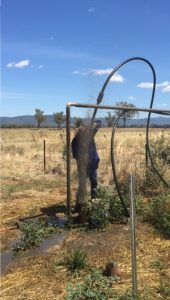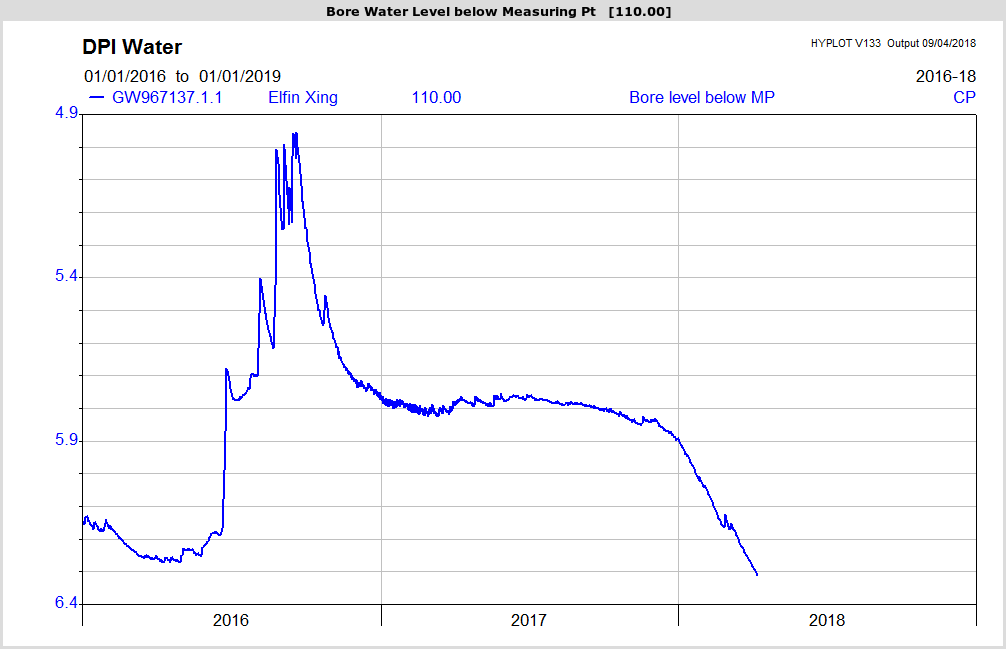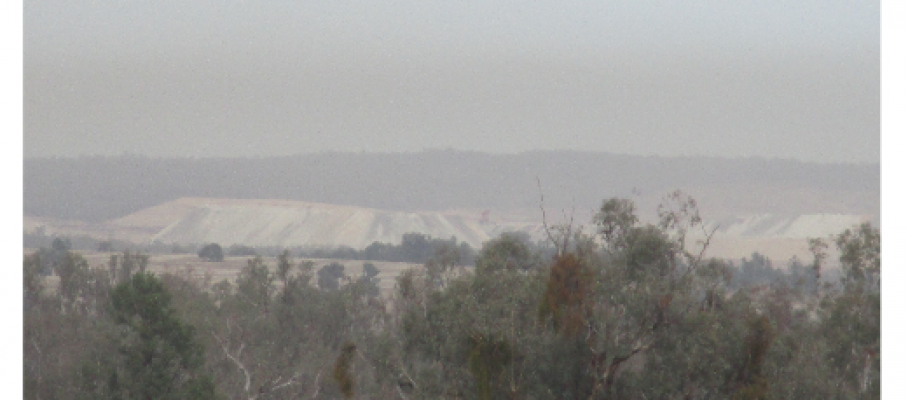Apr 9 2018
That sickening feeling when your water is at threat
Water levels are a very serious concern at Maules Creek as Elfin Crossing has stopped running.
Over the last 5 or 6 months bore levels have been dropping with corresponding falls in flow rates.
Local farmers have been cleaning out their water bores and searching for new sources of groundwater supplies for stock and domestic. Some have had success but water levels are still on the decline.


Most of us don’t think this is normal and it’s worthwhile putting the current situation in context with the last time water stopped running over Elfin Crossing.
A decade earlier in 2007, there really were exceptional circumstances.
- Year on year rainfall was very low, the district was drought declared and in the grip of a strong El Nino
- There were no significant rainfall events over 150 mm in any month of 2006-2007 period and subsequently no significant streamflow events in the catchment
- A new irrigation pump was extracting water nearby to Elfin crossing
In fact, 2007 rainfall records shown below from the BOM’s Mt Kaputar weather station recorded only 367 mm, around 1/3 of Mt Kaputar’s yearly average rainfall of 927 mm. The 367mm came on the back of a dry 2006 with only 600.2 mm recorded in that year.
Rainfall measurements at Mt Kaputar are important because they indicate rainfall events on the Nandewar Range more generally which feed the surface and groundwater systems at Maules Creek.
In contrast to 2006 and 2007, the 2016 and 2017 year on year totals were quite good, with the Mt Kaputar weather station recording 1062 mm and 923 mm respectively. Both years were at or above average totals and over that period there were 5 individual months with significant rainfall above 150 mm which could trigger streamflow in the creek system and aquifer recharge.
Monitoring data in the chart below from the Elfin groundwater gauge shows the impact on groundwater levels of the 2016 rainfall events and the maintenance of good groundwater levels throughout the average rainfall year of 2017.
 The chart clearly shows good groundwater levels throughout 2017, and a sudden sharp decline in groundwater levels commencing at the end of 2017.
The chart clearly shows good groundwater levels throughout 2017, and a sudden sharp decline in groundwater levels commencing at the end of 2017.
Compare this to the 2007 year Elfin Crossing groundwater readings where water levels were 1/2 a meter lower than current levels in 2018. Water levels did recover after the Zone 11 (i.e. Maules Creek) Water Sharing Plan commenced in late 2006. The Plan drastically cut irrigator’s water entitlements by 73% and this was followed up with Cease to Pump triggers in Dec 2007 which required irrigators to cease pumping when less than 1 ML/day of water was flowing across Elfin Crossing2.
Groundwater levels actually recovered shortly after the Water Sharing Plan was implemented – despite an abysmal rainfall total for the year of 367 mm. Levels recovered again in Dec 2007 when Cease to Pump restrictions came into force.
Given the data above we think its safe to conclude that;
- Its not that dry, compared to 2007 – when Elfin last stopped flowing
- Water is being extracted somewhere upstream from Elfin
- Cease to Pump triggers should be in place in Zone 11 and governments should act immediately
- Irrigation north of Elfin has effectively been abandoned leaving only one large extraction source – Maules Creek Coal Mine
- Water levels at Elfin can recover, even in a very dry year, with little to no rain, if extraction from the groundwater system is controlled
So where to from here?
- Its time for the Maules Creek Coal Mine to become transparent with its water usage
- The Minister should advise the company to stop allowing water to seep into the mine pit and drain the groundwater system until water flows again over the crossing at Elfin at 1 ML per day. Mine operations should halt until this is achieved.
Footnote
- Submission to Maules Creek Coal Mine http://ipcn.nsw.gov.au/resources/pac/media/files/pac/projects/2011/08/maules-creek-coal-project/submissions-received/submission-4-l-leitchpdf.pdf




Apr 2 2024
New Coal Expansion In A Time Of Climate Crisis
The Maules Creek coal mine expansion flies in the face of the impending climate crisis.
Here is a map showing the coal exploration area that is part of Whitehaven coal’s 17 year expansion plan that will see it ramping up it’s coal mining operation at Maules Creek to 14 million tonnes pa from 2028 – 2045. The miner says it will be drilling core holes to 600 meters in depth envisaging a pit of monstrous proportions with the combination of the new exploration area and the existing pit. It says;
‘Whitehaven Coal is planning to undertake exploration activities to the north of the Maules Creek Coal Mine within the “Wollondilly” property. The exploration program is expected to occur over a 12-month period from late March 2024. The activities will occur within the existing tenement Authorisation 346.
These exploration activities have been authorised by the Resources Regulator and will be carried out in accordance with the Exploration Code of Practice: Environmental Management (NSW Resources Regulator, 2021).1
The activities include:
The proposed expansion plans shown in the Scoping Report on the Planning Dept Website along with the Secretaries Environmental Assessment Requirements and agency responses.
By MCCC • Uncategorized • • Tags: climate, coal, crisis, expansion, Maules Creek